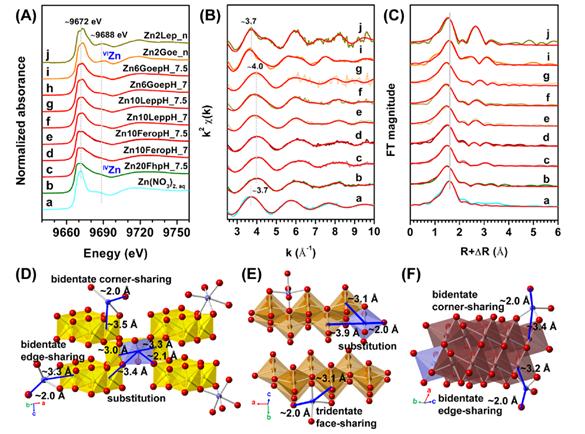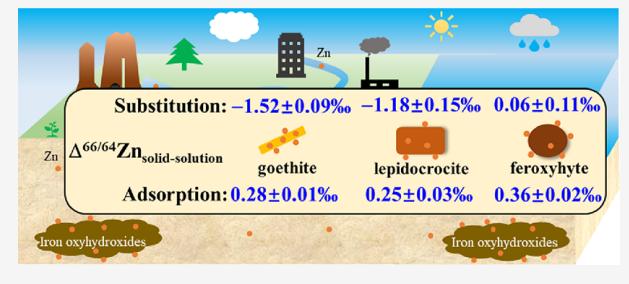南湖新闻网讯 (通讯员 严欣然)近日,我校资源与环境学院土壤矿物与环境团队殷辉副教授在铁氧化物表面Zn环境行为方面取得系列进展,相关成果分别以“Iron oxyhydroxide polytype (γ-, δ- and β-FeOOH) structures govern Zn mobility”和“Zinc Stable Isotope Fractionation Mechanisms during Adsorption on and Substitution in Iron (Hydr)oxides” 发表在欧洲地球化学会会刊《Chemical Geology》和环境科学领域期刊《Environmental Science & Technology》上。该研究揭示了重金属元素Zn在环境中常见FeOOH多型矿物表面赋存和矿物界面反应过程中Zn同位素分馏行为和机制,为Zn环境地球化学循环提供了深刻见解。
铁氧化物中FeOOH多型矿物如针铁矿(α-FeOOH)、纤铁矿(γ-FeOOH)、六方纤铁矿(δ-FeOOH)和四方纤铁矿(β-FeOOH)等,广泛存在于表生环境中,在调控重金属迁移、转化和有效性等方面发挥重要作用。但不同FeOOH多型矿物形成环境和结构的差异对重金属赋存机制、含量、移动性和同位素分馏行为的影响机制尚不清楚。本研究表明,纤铁矿和六方纤铁矿与Zn共沉淀过程中可以吸附和同晶替代等方式赋存高含量Zn(7.71±0.20 mol%和8.56±0.22 mol%)而四方纤铁矿中几乎不固定Zn (0.054±0.002 mol%)。FeOOH矿物中Zn替代量差异与矿物结构和矿物结晶pH密切相关。环境条件下,纤铁矿表面赋存的Zn较稳定,而六方纤铁矿表面Zn则很易释放。这些结果有助于理解铁氧化物表面Zn赋存机制及移动性,加深对富含氧化铁土壤中Zn缺乏以及污染土壤中Zn环境行为的理解。
重金属稳定同位素在地球历史演化、古环境/气候重建、重金属溯源和示踪等方面具有重要应用。但是环境中活性矿物表面各种界面过程会导致重金属稳定同位素分馏,其机制尚不清楚。本工作研究了Zn在针铁矿、纤铁矿和六方纤铁矿表面吸附和在矿物结构发生同晶替代过程中Zn赋存和同位素分馏机制。 同步辐射Zn K边X射线吸收精细结构光谱(XANES 和EXAFS)分析表明(图1),Zn在矿物表面主要以四面体形式存在,亦存在部分八面体;Zn在针铁矿和六方纤铁矿表面主要形成双齿共边、双齿共角内圈络合物,而在纤铁矿表面形成三齿共面络合物。铁氧化物表面Zn内圈络合物的平均Zn−O键长相同,均小于溶液中[ZnO6]八面体Zn-O键长。同位素分析表明,不同FeOOH矿物表面Zn吸附过程中,重Zn同位素优先富集到固体上,同位素分馏因子相同(Δ66/64Znsolid-solution = 0.25 ~ 0.36‰) (图2)。 在初始Zn/Fe摩尔比为0.02时Zn与铁氧化物共沉淀过程中,轻Zn同位素以同晶替代方式进入针铁矿和纤铁矿矿物晶格,分馏因子分别为-1.52±0.09‰和-1.18±0.15‰;而Zn替代六方纤铁矿过程中几乎没有同位素分馏(0.06±0.11‰) (图2)。这与Zn替代FeOOH多型矿物结晶成核和生长机制和速率不同密切相关。这些结果为全球红土剖面、酸性矿山废水矿物中Zn同位素分馏结果提供了直接的实验证据,加深了对矿物-溶液界面反应过程中Zn同位素分馏行为和机制的认识。

图1 Zn吸附和同晶替代铁氧化物Zn K边XANES(A)和EXAFS(B, C)谱和Zn内圈络合物结构示意图(D, 针铁矿; E, 纤铁矿; F, 六方纤铁矿)

图2 铁氧化物-水界面Zn同位素分馏因子
两篇论文分别以我校资源与环境学院已毕业硕士研究生胡碧云和博士研究生严欣然为论文共同第一作者,严欣然为第一作者,殷辉副教授为论文通讯作者。华中农业大学刘凡教授、内蒙古农业大学红梅教授、英国利兹大学Caroline L. Peacock教授、南京大学李伟教授、中国科学院高能物理研究所张静研究员、中国科学院地球化学研究所朱传威副研究员和刘意章副研究员等参与了该研究。该研究得到国家自然科学基金、内蒙古自治区科技重大专项和华中农业大学自主科技创新基金等项目资助。
英文摘要1:
The Zn isotope ingerprint is widely used as a proxy of various environmental geochemical processes, so it is crucial to determine which are the mechanisms responsible for isotopic fractionation. Iron (Fe) (hydr)oxides greatly control the cycling and fate and thus isotope fractionation factors of
Zn in terrestrial environments. Here, Zn isotope fractionation and related mechanisms during adsorption on and substitution in three FeOOH polymorphs are explored. Results demonstrate that heavy Zn isotopes are preferentially enriched onto solids, with almost similar isotopic offsets (Δ66/64Znsolid‑solution = 0.25−0.36‰) for goethite, lepidocrocite, and feroxyhyte. This is consistent with the same average Zn−O bond lengths for adsorbed Zn on these solids as revealed by Zn K-
edge X-ray absorption ine structure spectroscopy. In contrast, at an initial Zn/Fe molar ratio of 0.02, incorporation of Zn into goethite and lepidocrocite by substituting for lattice Fe preferentially sequesters light Zn isotopes with Δ66/64Znsubstituted‑stock solution of −1.52±0.09‰ and −1.18±0.15‰, while Zn-substituted feroxyhyte (0.06 ± 0.11‰) indicates almost no isotope fractionation. This is closely related to the diferent crystal nucleation and growth rates during the Zn-doped FeOOH formation processes. These results provide direct experimental evidence of incorporation of isotopically light Zn into Fe (hydr)oxides and improve our understanding of Zn isotope fractionation mechanisms during mineral−solution interface processes
论文链接:https://doi.org/10.1021/acs.est.2c08028
英文摘要2:
Iron oxyhydroxide polytype minerals, such as goethite (α-FeOOH), lepidocrocite (γ-FeOOH), feroxyhyte (δ-FeOOH) and akaganeite (β-FeOOH), widely exist in terrestrial environments, and play important roles in mediating heavy metal mobility. Previous studies mainly focus on goethite, while the other three polytypes have been rarely explored. In the present work, Zn retention contents and mechanisms in Zn-coprecipitated γ-, δ- and β-FeOOH minerals were thoroughly investigated. Additionally, Zn mobility during anoxic incubation of Zn- containing lepidocrocite and feroxyhyte samples was monitored. It demonstrates that, feroxyhyte and lepidocrocite can accommodate relatively higher amounts of Zn (7.71±0.20 mol% and 8.56±0.22 mol% respectively) than akaganeite that retains almost no Zn (0.054 ± 0.002 mol%). In contrast, Zn has the most significant effect on akaganeite morphology. Part of total Zn is incorporated into the lepidocrocite or feroxyhyte structure by substitution for lattice Fe while the remaining Zn is adsorbed on the mineral surfaces. The different Zn substitution levels in these FeOOH minerals are greatly related with the mineral structures, that is, the ratio of edge-sharing to corner-sharing [FeO6] and thus the spatial freedom, and the pHs of the mineral synthetic solutions. During anoxic incubation in the presence of 1 mM Fe2+ at pH 6±0.05 for 60 d, both Zn-containing lepidocrocite and feroxyhyte keep stable, while the dissolved Zn concentrations rapidly increase at initial stage, then decrease after reaction for 3 d, and increase again from 10 d till to the end. The inal Zn release from feroxyhyte (~98%) is much higher than that from lepidocrocite (~30%), probably owing to the higher Fe2+-induced reductive dissolution and desorption rates, and larger amounts of Zn adsorbed on the surfaces of the former. These results help to understand the effects of Zn on the physicochemical properties of FeOOH polymorphs and the geochemical behaviors of Zn associated with Fe oxyhydroxide minerals.
论文链接:https://doi.org/10.1016/j.chemgeo.2022.121167
审核人 殷辉